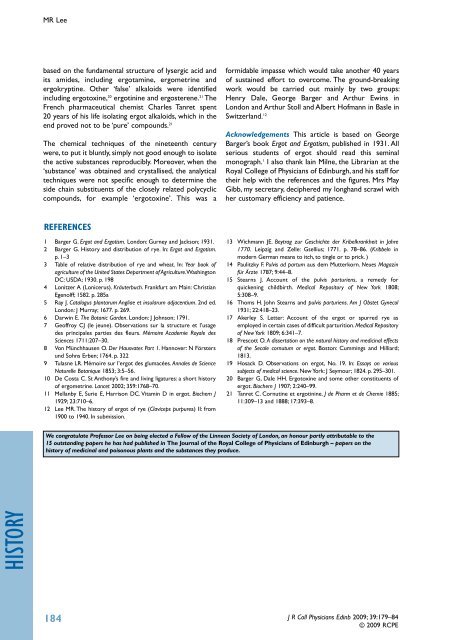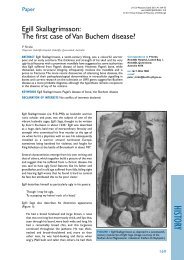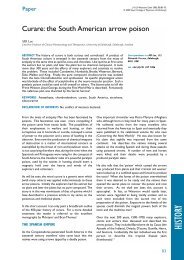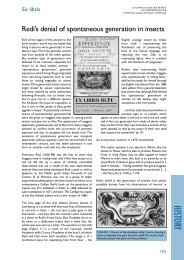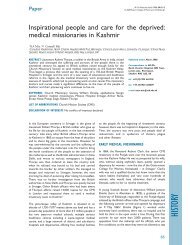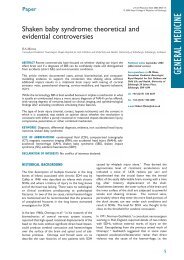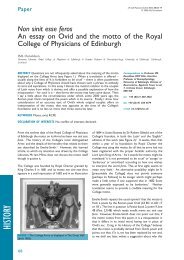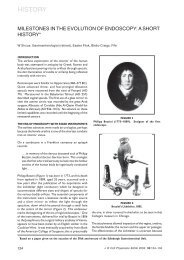The history of ergot of rye (Claviceps purpurea) I: From antiquity to ...
The history of ergot of rye (Claviceps purpurea) I: From antiquity to ...
The history of ergot of rye (Claviceps purpurea) I: From antiquity to ...
Create successful ePaper yourself
Turn your PDF publications into a flip-book with our unique Google optimized e-Paper software.
<strong>his<strong>to</strong>ry</strong><br />
MR Lee<br />
based on the fundamental structure <strong>of</strong> lysergic acid and<br />
its amides, including <strong>ergot</strong>amine, ergometrine and<br />
ergokryptine. Other ‘false’ alkaloids were identified<br />
including <strong>ergot</strong>oxine, 20 <strong>ergot</strong>inine and ergosterene. 21 <strong>The</strong><br />
French pharmaceutical chemist Charles Tanret spent<br />
20 years <strong>of</strong> his life isolating <strong>ergot</strong> alkaloids, which in the<br />
end proved not <strong>to</strong> be ‘pure’ compounds. 21<br />
<strong>The</strong> chemical techniques <strong>of</strong> the nineteenth century<br />
were, <strong>to</strong> put it bluntly, simply not good enough <strong>to</strong> isolate<br />
the active substances reproducibly. Moreover, when the<br />
‘substance’ was obtained and crystallised, the analytical<br />
techniques were not specific enough <strong>to</strong> determine the<br />
side chain substituents <strong>of</strong> the closely related polycyclic<br />
compounds, for example ‘<strong>ergot</strong>oxine’. This was a<br />
RefeReNCeS<br />
1 Barger G. Ergot and Ergotism. London: Gurney and Jackson; 1931.<br />
2 Barger G. His<strong>to</strong>ry and distribution <strong>of</strong> <strong>rye</strong>. In: Ergot and Ergotism.<br />
p. 1–3<br />
3 Table <strong>of</strong> relative distribution <strong>of</strong> <strong>rye</strong> and wheat. In: Year book <strong>of</strong><br />
agriculture <strong>of</strong> the United States Department <strong>of</strong> Agriculture. Washing<strong>to</strong>n<br />
DC: USDA; 1930. p. 198<br />
4 Lonitzer A (Lonicerus). Kräuterbuch. Frankfurt am Main: Christian<br />
Egenolff; 1582. p. 285a<br />
5 Ray J. Catalogus plantarum Angliae et insularum adjacentium. 2nd ed.<br />
London: J Murray; 1677. p. 269.<br />
6 Darwin E. <strong>The</strong> Botanic Garden. London: J Johnson; 1791.<br />
7 Ge<strong>of</strong>froy CJ (le jeune). Observations sur la structure et l’usage<br />
des principales parties des fleurs. Mémoire Academie Royale des<br />
Sciences 1711:207–30.<br />
8 Von Münchhausen O. Der Hausvater. Part 1. Hannover: N Försters<br />
und Sohns Erben; 1764. p. 322<br />
9 Tulasne LR. Mémoire sur l’<strong>ergot</strong> des glumacées. Annales de Science<br />
Naturelle Botanique 1853; 3:5–56.<br />
10 De Costa C. St Anthony’s fire and living ligatures: a short <strong>his<strong>to</strong>ry</strong><br />
<strong>of</strong> ergometrine. Lancet 2002; 359:1768–70.<br />
11 Mellanby E, Surie E, Harrison DC. Vitamin D in <strong>ergot</strong>. Biochem J<br />
1929; 23:710–6.<br />
12 Lee MR. <strong>The</strong> <strong>his<strong>to</strong>ry</strong> <strong>of</strong> <strong>ergot</strong> <strong>of</strong> <strong>rye</strong> (<strong>Claviceps</strong> <strong>purpurea</strong>) II: from<br />
1900 <strong>to</strong> 1940. In submission.<br />
184<br />
formidable impasse which would take another 40 years<br />
<strong>of</strong> sustained effort <strong>to</strong> overcome. <strong>The</strong> ground-breaking<br />
work would be carried out mainly by two groups:<br />
Henry Dale, George Barger and Arthur Ewins in<br />
London and Arthur S<strong>to</strong>ll and Albert H<strong>of</strong>mann in Basle in<br />
Switzerland. 12<br />
Acknowledgements This article is based on George<br />
Barger’s book Ergot and Ergotism, published in 1931. All<br />
serious students <strong>of</strong> <strong>ergot</strong> should read this seminal<br />
monograph. 1 I also thank Iain Milne, the Librarian at the<br />
Royal College <strong>of</strong> Physicians <strong>of</strong> Edinburgh, and his staff for<br />
their help with the references and the figures. Mrs May<br />
Gibb, my secretary, deciphered my longhand scrawl with<br />
her cus<strong>to</strong>mary efficiency and patience.<br />
13 Wichmann JE. Beytrag zur Geschichte der Kribelkrankheit in Jahre<br />
1770. Leipzig and Zelle: Gsellius; 1771. p. 78–86. (Kribbeln in<br />
modern German means <strong>to</strong> itch, <strong>to</strong> tingle or <strong>to</strong> prick. )<br />
14 Paulitzky F. Pulvis ad partum aus dem Mutterkorn. Neues Magazin<br />
für Ärzte 1787; 9:44–8.<br />
15 Stearns J. Account <strong>of</strong> the pulvis parturiens, a remedy for<br />
quickening childbirth. Medical Reposi<strong>to</strong>ry <strong>of</strong> New York 1808;<br />
5:308–9.<br />
16 Thoms H. John Stearns and pulvis parturiens. Am J Obstet Gynecol<br />
1931; 22:418–23.<br />
17 Akerley S. Letter: Account <strong>of</strong> the <strong>ergot</strong> or spurred <strong>rye</strong> as<br />
employed in certain cases <strong>of</strong> difficult parturition. Medical Reposi<strong>to</strong>ry<br />
<strong>of</strong> New York 1809; 6:341–7.<br />
18 Prescott O. A dissertation on the natural <strong>his<strong>to</strong>ry</strong> and medicinal effects<br />
<strong>of</strong> the Secale cornutum or <strong>ergot</strong>. Bos<strong>to</strong>n: Cummings and Hilliard;<br />
1813.<br />
19 Hosack D. Observations on <strong>ergot</strong>, No. 19. In: Essays on various<br />
subjects <strong>of</strong> medical science. New York: J Seymour; 1824. p. 295–301.<br />
20 Barger G, Dale HH. Ergo<strong>to</strong>xine and some other constituents <strong>of</strong><br />
<strong>ergot</strong>. Biochem J 1907; 2:240–99.<br />
21 Tanret C. Cornutine et <strong>ergot</strong>inine. J de Pharm et de Chemie 1885;<br />
11:309–13 and 1888; 17:393–8.<br />
We congratulate Pr<strong>of</strong>essor Lee on being elected a Fellow <strong>of</strong> the Linnean Society <strong>of</strong> London, an honour partly attributable <strong>to</strong> the<br />
15 outstanding papers he has had published in <strong>The</strong> Journal <strong>of</strong> the royal College <strong>of</strong> Physicians <strong>of</strong> edinburgh – papers on the<br />
<strong>his<strong>to</strong>ry</strong> <strong>of</strong> medicinal and poisonous plants and the substances they produce.<br />
J R Coll Physicians Edinb 2009; 39:179–84<br />
© 2009 RCPE


